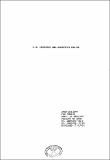Files in this item
D. H. Lawrence and narrative design
Item metadata
| dc.contributor.author | Elliott, John | |
| dc.coverage.spatial | x, 300 p. | en |
| dc.date.accessioned | 2006-11-21T17:35:56Z | |
| dc.date.available | 2006-11-21T17:35:56Z | |
| dc.date.issued | 1990-09-07 | |
| dc.identifier.uri | https://hdl.handle.net/10023/141 | |
| dc.description.abstract | Lawrence's work has almost invevitably been read as an aesthetic production whereby one must eventually agree or disagree with his vision of "reality". Those who assume a formalist standard of taste often find that Lawrence "loses control" of his material; those who offer ideological apologies for his work argue that disruptions in the aesthetic plane are representative of an exploratory genius, often seen as the outstanding characteristic of literary modernism. Both approaches, explicitly or otherwise , rely on the ultimate sanction of the achieved image, transmuted by the author always in control of his material. Yet anyone who reads Lawrence with an eye to to what the "tale" says in addition to what the "teller" claims discovers that Lawrence is not in full control of his material, thought it cannot simply be argued, on aesthetic or linguistic criteria, that he is out of control. Rather, there exists a "third" state whereby Lawrence both writes and is written, gives us a message with one hand, yet retracts, as it were, with the other. Because this double-move is preeminently suited to the language of fiction, and because it appears in Lawrence's fiction with the greatest versatility and incisiveness, this dissertation analyzes six of his novels for their rhetorical significance, understood as both an organization of tropes and figures and as a system of persuasive doctrine. A new definition for allegory is proposed, the introductions of thematic and structural "blanks" is examined, and a spread of narrative delays are identified and discussed, all concerned with the central problem of writing novels that direct themselves to the resurrection of a pre-linguistic universe, yet ironically depend more and more upon writing to bring this about. Ideas drawn from Continental philosophy and recent critical theory are incorporated for support and instruction. Attention is also focused on Lawrence's revision processes, often with specific emphasis on unpublished manuscript material. | en |
| dc.format.extent | 28154570 bytes | |
| dc.format.mimetype | application/pdf | |
| dc.language.iso | en | en |
| dc.publisher | University of St Andrews | |
| dc.rights | Creative Commons Attribution-NonCommercial-NoDerivs 2.5 Generic | |
| dc.rights.uri | http://creativecommons.org/licenses/by-nc-nd/2.5/ | |
| dc.subject | D. H. Lawrence | en |
| dc.subject | Fiction | en |
| dc.subject | Allegory | en |
| dc.subject | Novels | en |
| dc.subject.lcc | PR6023.A8Z5E6 | |
| dc.subject.lcsh | Lawrence, D. H. (David Herbert), 1885-1930 | |
| dc.title | D. H. Lawrence and narrative design | en |
| dc.type | Thesis | en |
| dc.type.qualificationlevel | Doctoral | en |
| dc.type.qualificationname | PhD Doctor of Philosophy | en |
| dc.publisher.institution | The University of St Andrews | en |
This item appears in the following Collection(s)
Except where otherwise noted within the work, this item's licence for re-use is described as Creative Commons Attribution-NonCommercial-NoDerivs 2.5 Generic
Items in the St Andrews Research Repository are protected by copyright, with all rights reserved, unless otherwise indicated.


